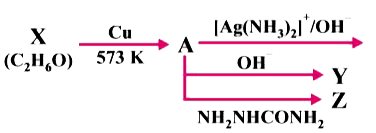Y' is obtained by the decomposition of a substance 'X'. Oxygen present in 'X' is univalent. 'Y' reacts with a neutral oxide and evolves 'Z' which is composed of reddish brown fumes which turns moist blue litmus red. Identify 'X', 'Y' and 'Z'.
H2O2,H2 and CO2
H2O2,O2 and NO2
KCIO3,Cl2 and O2
HgO,O2 and NO
The correct Answer is:B
To solve the problem, we need to identify substances X, Y, and Z based on the given clues. Let's break it down step by step.
Step 1: Identify Substance X
- The problem states that "Y is obtained by the decomposition of a substance 'X'."
- It also mentions that "Oxygen present in 'X' is univalent."
- Univalent means that the valency of oxygen in this case is 1.
- The only common substance that fits this description is Hydrogen Peroxide (H₂O₂). In H₂O₂, the oxidation state of oxygen is -1, which is univalent.
Step 2: Identify Substance Y
- Since Y is obtained from the decomposition of X (H₂O₂), we need to consider the decomposition reaction of hydrogen peroxide.
- When H₂O₂ decomposes, it produces water (H₂O) and oxygen gas (O₂). Therefore, Y = O₂ (Oxygen gas).
Step 3: Identify Substance Z
- The problem states that "Y reacts with a neutral oxide and evolves 'Z' which is composed of reddish-brown fumes."
- A common neutral oxide is nitrogen dioxide (NO₂), which can react with oxygen.
- When oxygen (Y) reacts with nitrogen dioxide (NO₂), it can produce nitrogen tetroxide (N₂O₄) and nitrogen monoxide (NO), which can further react to produce reddish-brown fumes of nitrogen dioxide (NO₂).
- The reddish-brown fumes that turn moist blue litmus red indicate the presence of an acidic gas, which is Z = NO₂ (Nitrogen Dioxide).
Final Identification
- X = Hydrogen Peroxide (H₂O₂)
- Y = Oxygen (O₂)
- Z = Nitrogen Dioxide (NO₂)
- The problem states that "Y is obtained by the decomposition of a substance 'X'."
- It also mentions that "Oxygen present in 'X' is univalent."
- Univalent means that the valency of oxygen in this case is 1.
- The only common substance that fits this description is Hydrogen Peroxide (H₂O₂). In H₂O₂, the oxidation state of oxygen is -1, which is univalent.
- Since Y is obtained from the decomposition of X (H₂O₂), we need to consider the decomposition reaction of hydrogen peroxide.
- When H₂O₂ decomposes, it produces water (H₂O) and oxygen gas (O₂). Therefore, Y = O₂ (Oxygen gas).
- The problem states that "Y reacts with a neutral oxide and evolves 'Z' which is composed of reddish-brown fumes."
- A common neutral oxide is nitrogen dioxide (NO₂), which can react with oxygen.
- When oxygen (Y) reacts with nitrogen dioxide (NO₂), it can produce nitrogen tetroxide (N₂O₄) and nitrogen monoxide (NO), which can further react to produce reddish-brown fumes of nitrogen dioxide (NO₂).
- The reddish-brown fumes that turn moist blue litmus red indicate the presence of an acidic gas, which is Z = NO₂ (Nitrogen Dioxide).
- X = Hydrogen Peroxide (H₂O₂)
- Y = Oxygen (O₂)
- Z = Nitrogen Dioxide (NO₂)
Topper's Solved these Questions
- BOOK - PEARSON IIT JEE FOUNDATIONCHAPTER - AIR AND OXYGENEXERCISE - level - 35videos
AIR AND OXYGEN
- BOOK - PEARSON IIT JEE FOUNDATIONCHAPTER - AIR AND OXYGENEXERCISE - Assemssment Test-115videos
AIR AND OXYGEN
- BOOK - PEARSON IIT JEE FOUNDATIONCHAPTER - AIR AND OXYGENEXERCISE - CONCEPT APPLICATION (Level-1)40videos
AIR AND OXYGEN
- BOOK - PEARSON IIT JEE FOUNDATIONCHAPTER - ACIDS, BASES AND SALTSEXERCISE - ASSESMENT TEST (TEST 2)15videos
ACIDS, BASES AND SALTS
- BOOK - PEARSON IIT JEE FOUNDATIONCHAPTER - ATOMIC STRUCTURE AND TRANSFORMATION OF MATTEREXERCISE - Assessment Test 215videos
ATOMIC STRUCTURE AND TRANSFORMATION OF MATTER
Similar Questions
Knowledge Check
- Question 1 - Select One
Y' is obtained by the decomposition of a substance 'X'. Oxygen present in 'X' is univalent. 'Y' reacts with a neutral oxide and evolves 'Z' which is composed of reddish brown fumes which turns moist blue litmus red. Identify 'X', 'Y' and 'Z'.
AH2O2,H2 and CO2BH2O2,O2 and NO2CKClO3,Cl2 and O2DHgO,O2 and NO - Question 2 - Select One
Y' is obtained by the decomposition of a substance 'X'. Oxygen present in 'X' is univalent. 'Y' reacts with a neutral oxide and evolves 'Z' which is composed of reddish brown fumes which turns moist blue litmus red. Identify 'X', 'Y' and 'Z'.
AH2O2,H2 and CO2BH2O2,O2 and NO2CKCIO3,CI2 and O2DHgO,O2 and NO - Question 3 - Select One
 . Identify X,A,Y,Z. AA-methoxymethane, X-ehtanol,Y-ethanoic acid, Z-semicarbazideBA-ethanol, X-ethano,Y-but -z-enal, Z-semicarbazone.CA-ehtanol,X-Acetaldehyde, Y-Butanone, Z-HydroazoneDA-Methoxymethane, X-ethanoicacid, Y-acetate ion and Z-Hydrazine.
. Identify X,A,Y,Z. AA-methoxymethane, X-ehtanol,Y-ethanoic acid, Z-semicarbazideBA-ethanol, X-ethano,Y-but -z-enal, Z-semicarbazone.CA-ehtanol,X-Acetaldehyde, Y-Butanone, Z-HydroazoneDA-Methoxymethane, X-ethanoicacid, Y-acetate ion and Z-Hydrazine.
A nonmetal 'X' is an important constituent of all living organisms and it forms two oxides Y and Z which are gases. Y is toxic while Z is responsible for global warming. Identify X, Y and Z.
View SolutionThe elemene 'X' has only three shells in which the difference in number of electrons between last shell and second last shell is equal to number of electron in the first shell. This element 'X' burns in oxygen to produce compound y, which turns acidified potassium dichromate paper green. Y turns moist blue litmus paper red due to the formation of componund Z. Identify X, Y and Z.
View SolutionAn element X forms an oxide XO which turns red litmus blue. Identify X.
View Solution_________ is the process in which iron reacts with oxygen and water vapours present in air and turns into a reddish-brown substance.
View SolutionAn element X burns with a brilliant blue flame in the presence of oxygen to form Y.Y turns acidified potassium dichromate paper green. Identify X and Y.
View Solution


